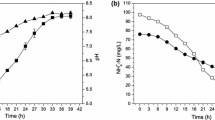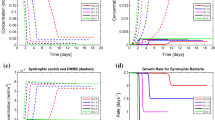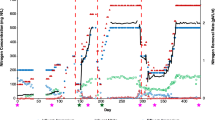Abstract
We present a quasi-steady state mechanistic derivation of the Monod bioreaction equation based upon a conceptual model involving aqueous phase diffusive transport of substrate towards a spherical microbe; transport of the substrate across its surface membrane; and reaction depleting the substrate within the microbe. The resulting Monod coefficients \({K}_{S}\) and \({\mu }_{\mathrm{max}}\) are dependent upon substrate-species pairs and the mass transfer properties of the system. Two substrate transport scenarios are investigated: (1) a constant rate model that is a function of a constant flux across the surface of the microbe; and (2) a linear rate model that is the product of a constant transport velocity and the concentration of substrate in contact with the surface of the microbe. The model is verified and parameterized using benzene, toluene, and phenol depletion and biomass growth data obtained from Reardon et al. (Biotechnol Bioeng: 385–400, 2000). Calibration results indicate a normalized surface to bulk concentration ratio of nearly unity in all simulations for benzene, toluene, and phenol when paired with P. putida F1, implying that the process is not aqueous phase diffusion limited.




Similar content being viewed by others
References
Alexander M (1999) Biodegradation and bioremediation, 2nd edn. Academic, New York
Alexander M (1985) Biodegradation of organic chemicals. Environ Sci Technol 19(2)
Bird RB, Stewart WE, Lightfoot EN (2007) Transport phenomena. Wiley, New York
Button DK (1998) Nutrient uptake by microorganisms according to kinetic parameters from theory as related to cytoarchitecture. Microbiol Mol Biol Rev 62:636–645
Chen Y, Nielsen J (2019) Energy metabolism controls phenotypes by protein efficiency and allocation. PNAS. https://doi.org/10.1073/pnas.1906569116
Hearn EM, Patel DR, van den Berg B (2008) Outer-membrane transport of aromatic hydrocarbons as a first step in biodegradation. PNAS 105(25):8601–8606. https://doi.org/10.1073/pnas.0801264105
Heijnen JJ, Romein B (1995) Derivation of kinetic equation for growth on single substrates based on general properties of a simple metabolic network. Biotechnol Prog 11:712–716
Hill AV (1910) The possible effects of the aggregation of the molecules of hæmoglobin on its dissociation curves. J Physiol 40(Suppl):iv–vii. https://doi.org/10.1113/jphysiol.1910.sp001386
Hua F, Wang HQ (2014) Uptake and trans-membrane transport of petroleum hydrocarbons by microorganisms. Biotechnol Biotechnol Equip 28(2):165–175. https://doi.org/10.1080/13102818.2014.906136
Jin Q, Bethke CM (2003) A new rate law describing microbial respiration. Appl Environ Microbiol 69:2340–2348
Kargi F (2009) Re-interpretation of the logistic equation for batch microbial growth in relation to Monod kinetics. Soc Appl Microbiol Lett Appl Microbiol 48(2009):398–401
Liu Y (2006) A simple thermodynamic approach for derivation of a general Monod equation for microbial growth. Biochem Eng J 31(2006):102–105
Liu Y (2007) Overview of some theoretical approaches for derivation of the Monod equation. Appl Microbiol Biotechnol 73:1241–1250
Lobry JR, Flandrois JP, Carret G, Pave A (1992) Monod’s bacterial growth model revisited. Bull Math Biol 54:117–122
Merchuk JC, Asenjo JA (1995) The Monod equation and mass transfer. Biotechnol Bioeng 45:91–94
Michaelis L, Menten ML (1913) Die Kinetik Der Invertinwirkung. Biochem z 49:333–369
Monod J (1949) The growth of bacterial cultures. Annu Rev Microbiol 3:371–394
Reardon KF, Mosteller DC, Bull Rogers JD (2000) Biodegradation kinetics of benzene, toluene, and phenol as single and mixed substrates for Pseudomonas putida F1. Biotechnol Bioeng 69(4):385–400
Shaw AR, Takács I, Pagilla KR, Murthy S (2013) A new approach to assess the dependency of extant half-saturation coefficients on maximum process rates and estimate intrinsic coefficients. WaterRes 47:5986–5994
Shaw AR, Takács I, Pagilla K, Riffat R, DeClippeleir H, Wilson C, Murthy S (2015) Toward universal half-saturation coefficients: describing extant KS as a function of diffusion. Water Environ Res 87(5):387–391
Tan Y, Wang ZX, Schneider RP, Marshall KC (1994) Modeling microbial growth: a statistical thermodynamic approach. J Biotechnol 32:97–106
Westerhoff HV, Lolkema JS, Otto R, Hellingwerf KJ (1982) Thermodynamics of growth. Non-equilibrium thermodynamics of bacterial growth. The phenomenological and the mosaic approach. Biochem Biophys Acta 683:181–220
Wilson CA, Novak J, Takács I, Wett B, Murthy S (2012) The kinetics of process dependent ammonia inhibition of methanogenesis from acetic acid. Water Res 46:6247–6256
Acknowledgements
Financial support for this research was provided by a NSERC CRDPJ 531663-18 Grant in participation with Chevron Technical Center (a Chevron U.S.A. Inc. division), and Chevron Canada Resources, Calgary, AB, Canada.
Author information
Authors and Affiliations
Corresponding author
Additional information
Publisher's Note
Springer Nature remains neutral with regard to jurisdictional claims in published maps and institutional affiliations.
Appendices
Appendix A: Constant Rate Model
-
(a)
First, we solve for \({\left({k}_{L}\alpha \right)}_{dq}\).
Let \({C}_{d}(r,t)\) be microscale concentration of donor \(d\) in the aqueous phase \(q\) for \(r>{r}_{b}\), and \(t>0\).
$$\frac{{D}_{dq}^{*}}{{r}^{2}}\frac{\partial }{\partial r}\left({r}^{2}\frac{\partial {C}_{d}}{\partial r}\right)=\frac{\partial {C}_{d}}{\partial t}$$(A.1a)and assuming steady state (no accumulation)
$$\frac{{D}_{dq}^{*}}{{r}^{2}}\frac{d}{dr}\left({r}^{2}\frac{d{C}_{d}}{dr}\right)=0$$(A.1b)For \(r={r}_{b}\)
$$\frac{{A}_{b}}{{V}_{b}}{\mathbb{J}}_{d}={R}_{db}$$(A.2a)$$\frac{3}{{r}_{b}}{\mathbb{J}}_{d}={R}_{db}$$(A.2b)where:\({A}_{b}=4\pi {r}_{b}^{2}\); \({V}_{b}=\frac{4}{3}\pi {r}_{b}^{3}\); \({R}_{db}\) is the microscale reaction rate within the volume of the microbe; and \({\mathbbm{n}}_{db}\) is the microscale flux of the substrate across the surface of the single spherical microbe shown on Fig. 1 at \(r={r}_{b}\) and with \({\mathbb{J}}_{d}={\mathbbm{n}}_{db}\) being constant, per Eq. (10a).
We solve Eqs. (A.1b) and (A.2b) subject to the following conditions:
$${C}_{dq,\mathrm{bulk}}\equiv {\left.{C}_{d}(r)\right|}_{\forall r\ge {r}_{c}}$$(A.3a)$${C}_{d}({r}_{b}^{+})={\kappa }_{db} {C}_{d}({r}_{b}^{-})$$(A.3b)$${D}_{dq}^{*}{\left.\frac{d{C}_{d}}{dr}\right|}_{r\to {r}_{b}^{+}}={\mathbb{J}}_{d}$$(A.3c)where \({C}_{d}(r)\) is the concentration of donor d in the biomass phase \(b\) for \(r<{r}_{b}\) and \(t>0\), and A.3b is our assumption of membrane transport processes.
First, we integrate Eq. A.1b w.r.t. \(r\) as:
$${r}^{2}\frac{d{C}_{d}}{dr}={\beta }_{1}$$$$\frac{d{C}_{d}}{dr}=\frac{{\beta }_{1}}{{r}^{2}}$$$${C}_{d}=-\frac{{\beta }_{1}}{r}+{\beta }_{2}$$(A.4)Using Eq. (A.3a) under the assumption that \({r}_{c}\to \infty \) and then combining with Eq. (A.4) yields:
$${C}_{dq,\mathrm{bulk}}={\beta }_{2}$$(A.5)Substituting Eq. (A.4) with Eq. (A.3b) at \(r={r}_{b}\) yields:
$$-\frac{{\beta }_{1}}{{r}_{b}}+{C}_{dq,\mathrm{bulk}}={\kappa }_{db}{ C}_{d}({r}_{b}^{-})$$$${\beta }_{1}=\left({C}_{dq,\mathrm{bulk}}-{\kappa }_{db} {C}_{d}({r}_{b}^{-})\right) {r}_{b}$$(A.6)We can now rewrite Eq. (A.4) as:
$${C}_{d}=-\frac{{r}_{b}}{r}\left({C}_{dq,\mathrm{bulk}}-{\kappa }_{db} {C}_{d}({r}_{b}^{-})\right)+{C}_{dq,\mathrm{bulk}}$$(A.7)Now, taking the derivative of Eq. (A.7) w.r.t. \(r\) and evaluating at position \(r\to {r}_{b}^{+}\) yields:
$${\left.\frac{d{C}_{d}}{dr}\right|}_{r\to {r}_{b}^{+}}=\frac{1}{{r}_{b}}\left({C}_{dq,\mathrm{bulk}}-{\kappa }_{db} {C}_{d}({r}_{b}^{-})\right)$$(A.8)Substituting Eq. (A.8) into (A.3c) yields:
$${\mathbbm{n}}_{db}=\frac{{D}_{dq}^{*}}{{r}_{b}}\left({C}_{dq,\mathrm{bulk}}-{\kappa }_{db} {C}_{d}({r}_{b}^{-})\right)$$(A.9)Next, substituting Eq. (A.2b) into Eq. (A.9) yields:
$$\frac{{r}_{b}}{3}{R}_{db}=\frac{{D}_{dq}^{*}}{{r}_{b}}\left({C}_{dq,\mathrm{bulk}}-{\kappa }_{db} {C}_{d}({r}_{b}^{-})\right)$$(A.10a)$$\left({C}_{dq,\mathrm{bulk}}-{\kappa }_{db} {C}_{d}({r}_{b}^{-})\right)\frac{{3D}_{dq}^{*}}{{r}_{b}^{2}}={R}_{db}$$(A.10b)From Eq. (A.3b), we have:
$$\left({C}_{dq,\mathrm{bulk}}-{C}_{d}({r}_{b}^{+})\right)\frac{{3D}_{dq}^{*}}{{r}_{b}^{2}}={R}_{db}$$(A.11a)$$\left({C}_{dq,\mathrm{bulk}}-{C}_{d}({r}_{b}^{+})\right){\left({k}_{L}\alpha \right)}_{dq}={R}_{db}$$(A.11b)where,
$${k}_{L}=\frac{{D}_{dq}^{*}}{{r}_{b}}$$(A.12a)$$\alpha =\frac{3}{{r}_{b}}$$(A.12b) -
(b)
Next, we solve for the surface concentration \({C}_{d}({r}_{b}^{+})\). We begin with Eq. (A.11a) as:
$$\left({C}_{dq,\mathrm{bulk}}-{C}_{d}({r}_{b}^{+})\right)\frac{3 {D}_{dq}^{*}}{{r}_{b}^{2}}={R}_{db}$$(A.13)but \(\frac{3}{{r}_{b}}{\mathbbm{n}}_{db}={R}_{db}\) from Eq. (A.2b). Therefore, we can rewrite Eq. (A.13) as:
$$\left({C}_{dq,\mathrm{bulk}}-{C}_{d}({r}_{b}^{+})\right)\frac{3 {D}_{dq}^{*}}{{r}_{b}^{2}}=\frac{3}{{r}_{b}}{\mathbbm{n}}_{db}$$(A.14a)$${C}_{dq,\mathrm{bulk}}-{C}_{d}({r}_{b}^{+})=\frac{{r}_{b}}{{D}_{dq}^{*}}{\mathbbm{n}}_{db}$$(A.14b)$${C}_{d}({r}_{b}^{+})={C}_{dq,\mathrm{bulk}}-\frac{{r}_{b}}{{D}_{dq}^{*}}{\mathbbm{n}}_{db}$$(A.14c)$${C}_{d}({r}_{b}^{-})=\frac{1}{{\kappa }_{db}}\left({C}_{dq,\mathrm{bulk}}-\frac{{r}_{b}}{{D}_{dq}^{*}}{\mathbbm{n}}_{db}\right)$$(A.14d) -
(c)
Next, we solve the concentration \({C}_{d}\) as a function of radius \(r>{r}_{b}\). We begin with Eq. (A.7) as:
$${C}_{d}=-\frac{{r}_{b}}{r}\left({C}_{dq,\mathrm{bulk}}-{C}_{d}({r}_{b}^{+})\right)+{C}_{dq,\mathrm{bulk}}$$(A.15)Now, substitute Eq. (A.14c) into (A.15) as:
$$ \begin{aligned} C_{d} & = - \frac{{r_{b} }}{r}\left( {C_{{{\text{dq}},{\text{bulk}}}} - \left[ {C_{{{\text{dq}},{\text{bulk}}}} - \frac{{r_{b} }}{{D_{{{\text{dq}}}}^{*} }}\mathbbm{n}_{{{\text{db}}}} } \right]} \right) + C_{{{\text{dq}},{\text{bulk}}}} \\ & = C_{{{\text{dq}},{\text{bulk}}}} - \frac{{r_{b}^{2} }}{{r D_{{{\text{dq}}}}^{*} }}\mathbbm{n}_{{{\text{db}}}} \\ \end{aligned} $$(A.16) -
(d)
Next, we solve for \({\left({k}_{L}\alpha \right)}_{db}\). We begin by rewriting Eq. (4a) as:
$${J}_{db}={J}_{dq}$$(A.17a)$${\left({k}_{L}\alpha \right)}_{db}{C}_{d}({r}_{b}^{-})={\left({k}_{L}\alpha \right)}_{dq}\left({C}_{dq,\mathrm{bulk}}-{C}_{d}({r}_{b}^{+})\right)$$(A.17b)$${\left({k}_{L}\alpha \right)}_{db} ={\left({k}_{L}\alpha \right)}_{dq}\frac{\kappa \left({C}_{dq,\mathrm{bulk}}-{C}_{d}({r}_{b}^{+})\right)}{{C}_{d}({r}_{b}^{+})}$$(A.17c)$${\left({k}_{L}\alpha \right)}_{db} =\frac{3 {D}_{dq}^{*}}{{r}_{b}^{2}}\frac{{\kappa }_{db}\left({C}_{dq,\mathrm{bulk}}-\left[{C}_{dq,\mathrm{bulk}}-\frac{{r}_{b}}{{D}_{dq}^{*}}{\mathbbm{n}}_{db}\right]\right)}{{C}_{d}({r}_{b}^{+})}$$(A.17d)$${\left({k}_{L}\alpha \right)}_{db} =\frac{3 {D}_{dq}^{*}}{{r}_{b}^{2}}\frac{{\kappa }_{db}\frac{{r}_{b}}{{D}_{dq}^{*}}{\mathbbm{n}}_{db}}{{C}_{d}({r}_{b}^{+})}$$(A.17e)$${\left({k}_{L}\alpha \right)}_{db}=\frac{3}{{r}_{b}} \frac{{\kappa }_{db} {\mathbbm{n}}_{db}}{{C}_{d}({r}_{b}^{+})}$$(A.17f) -
(e)
Next, we solve for the Monod \({K}_{S}\). We begin by rewriting Eq. (8b) as:
$$ \begin{aligned} K_{S} & = \frac{1}{{\kappa_{{{\text{db}}}} }}\frac{{\left( {k_{L} \alpha } \right)_{{{\text{db}}}} }}{{\left( {k_{L} \alpha } \right)_{{{\text{dq}}}} }}C_{{{\text{dq}},{\text{bulk}}}} \\ & = \frac{1}{{\kappa_{{{\text{db}}}} }}\frac{{\frac{{3 D_{{{\text{dq}}}}^{*} }}{{r_{b}^{2} }}}}{{\frac{{3 D_{{{\text{dq}}}}^{*} }}{{r_{b}^{2} }}}}\frac{{\kappa_{{{\text{db}}}} \frac{{r_{b} }}{{D_{{{\text{dq}}}}^{*} }}\mathbbm{n}_{{{\text{db}}}} }}{{C_{d} \left( {r_{b}^{ + } } \right)}}C_{{{\text{dq}},{\text{bulk}}}} \\ & = \frac{{r_{b} }}{{D_{{{\text{dq}}}}^{*} }} \mathbbm{n}_{{{\text{db}}}} \frac{{C_{{{\text{dq}},\,{\text{bulk}}}} }}{{C_{d} \left( {r_{b}^{ + } } \right)}} \\ \end{aligned} $$(A.18)For the condition that \(\frac{{C}_{dq,\mathrm{bulk}}}{{C}_{d}({r}_{b}^{+})}\cong 1\), \({K}_{S}\) can be interpreted as a constant:
$${K}_{S}\cong \frac{{r}_{b}}{{D}_{dq}^{*}}{\mathbbm{n}}_{db}$$(A.19) -
(f)
Finally, we solve for the Monod \({\mu }_{\mathrm{max}}\). We begin by rewriting Eq. (8c) as:
$$ \begin{aligned} \mu_{\max } & = \left( {k_{L} \alpha } \right)_{{{\text{db}}}} C_{{{\text{dq}},{\text{bulk}}}} \\ & = \frac{{Y_{{{\text{db}}}} }}{{\kappa_{{{\text{db}}}} \rho_{b} }} \frac{3}{{r_{b} }} \frac{{\kappa_{{{\text{db}}}} \mathbbm{n}_{{{\text{db}}}} }}{{C_{d} \left( {r_{b}^{ + } } \right)}}C_{{{\text{dq}},{\text{bulk}}}} \\ & = \frac{{Y_{{{\text{db}}}} }}{{\rho_{b} }} \frac{3}{{r_{b} }}\mathbbm{n}_{{{\text{db}}}} \frac{{C_{{{\text{dq}},{\text{bulk}}}} }}{{C_{d} \left( {r_{b}^{ + } } \right)}} \\ \end{aligned} $$(A.20a)For the condition that \(\frac{{C}_{dq,\mathrm{bulk}}}{{C}_{d}({r}_{b}^{+})}\cong 1\), \({\mu }_{\mathrm{max}}\) can be interpreted as a constant:
$${\mu }_{\mathrm{max}}\cong \frac{{Y}_{db}}{{\rho }_{b}} \frac{3}{{r}_{b}}{\mathbbm{n}}_{db}$$(A.21)
Appendix B: Linear rate model
-
(a)
First, we solve for \({\left({k}_{L}\alpha \right)}_{dq}\).
Let \({C}_{d}(r,t)\) be microscale concentration of donor \(d\) in the aqueous phase \(q\) for \(r>{r}_{b}\), and \(t>0\).
$$\frac{{D}_{dq}^{*}}{{r}^{2}}\frac{\partial }{\partial r}\left({r}^{2}\frac{\partial {C}_{d}}{\partial r}\right)=\frac{\partial {C}_{d}}{\partial t}$$(B.1a)and assuming steady state (no accumulation)
$$\frac{{D}_{dq}^{*}}{{r}^{2}}\frac{d}{dr}\left({r}^{2}\frac{d{C}_{d}}{dr}\right)=0$$(B.1b)For \(r={r}_{b}\)
$$\frac{{A}_{b}}{{V}_{b}}{\mathbb{J}}_{d}={R}_{db}$$(B.2a)$$\frac{3}{{r}_{b}}{\mathbb{J}}_{d}={R}_{db}$$(B.2b)where:\({A}_{b}=4\pi {r}_{b}^{2}\); \({V}_{b}=\frac{4}{3}\pi {r}_{b}^{3}\); \({R}_{db}\) is the microscale reaction rate within the volume of the microbe; and, \({\mathbbm{v}}_{db}\) is the microscale transport velocity across the surface of the single spherical microbe shown on Fig. 1 with \({\mathbb{J}}_{d}={\mathbbm{v}}_{db}{C}_{d}({r}_{b}^{-})\) being variable and a function of the surface concentration \({C}_{d}({r}_{b}^{-})\).
We solve Eqs. (B.1b) and (B.2b) subject to the conditions stated in Eq. (A.3).
First, we integrate Eq. (B.1b) w.r.t. \(r\) as:
$${r}^{2}\frac{d{C}_{d}}{dr}={\beta }_{1}$$$$\frac{d{C}_{d}}{dr}=\frac{{\beta }_{1}}{{r}^{2}}$$$${C}_{d}=-\frac{{\beta }_{1}}{r}+{\beta }_{2}$$(B.3)Using Eq. (A.3a) under the assumption that \({r}_{c}\to \infty \) and then combining with Eq. (B.3) yields:
$${C}_{dq,\mathrm{bulk}}={\beta }_{2}$$(B.4)Substituting Eq. (B.3) with Eq. (A.3b) at \(r={r}_{b}\) yields:
$$-\frac{{\beta }_{1}}{{r}_{b}}+{C}_{dq,\mathrm{bulk}}={\kappa }_{db} {C}_{d}({r}_{b}^{-})$$$${\beta }_{1}=\left({C}_{dq,\mathrm{bulk}}-{\kappa }_{db} {C}_{d}({r}_{b}^{-})\right) {r}_{b}$$(B.5)We can now rewrite Eq. (B.3) as:
$${C}_{d}=-\frac{{r}_{b}}{r}\left({C}_{dq,\mathrm{bulk}}-{\kappa }_{db} {C}_{d}({r}_{b}^{-})\right)+{C}_{dq,\mathrm{bulk}}$$(B.6)Now, taking the derivative of Eq. (B.6) w.r.t. \(r\) and evaluating at position \(r={r}_{b}\) yields:
$${\left.\frac{d{C}_{d}}{dr}\right|}_{r\to {r}_{b}^{+}}=\frac{1}{{r}_{b}}\left({C}_{dq,\mathrm{bulk}}-{\kappa }_{db} {C}_{d}({r}_{b}^{-})\right)$$(B.7)Substituting Eq. (B.7) into (A.3c) yields:
$${\mathbbm{v}}_{db}{C}_{d}({r}_{b}^{-})=\frac{{D}_{dq}^{*}}{{r}_{b}}\left({C}_{dq,\mathrm{bulk}}-{\kappa }_{db} {C}_{d}({r}_{b}^{-})\right)$$(B.8)Next, substituting Eq. (B.2b) into Eq. (B.8) yields:
$$\frac{{r}_{b}}{3}{R}_{db}=\frac{{D}_{dq}^{*}}{{r}_{b}}\left({C}_{dq,\mathrm{bulk}}-{\kappa }_{db} {C}_{d}({r}_{b}^{-})\right)$$(B.9a)$$\left({C}_{dq,\mathrm{bulk}}-{\kappa }_{db} {C}_{d}({r}_{b}^{-})\right)\frac{{3D}_{dq}^{*}}{{r}_{b}^{2}}={R}_{db}$$(B.9b)From Eq. (A.3b), we have:
$$\left({C}_{dq,\mathrm{bulk}}-{C}_{d}({r}_{b}^{+})\right)\frac{{3D}_{dq}^{*}}{{r}_{b}^{2}}={R}_{db}$$(B.10a)$$\left({C}_{dq,\mathrm{bulk}}-{C}_{d}({r}_{b}^{+})\right){\left({k}_{L}\alpha \right)}_{dq}={R}_{db}$$(B.10b)where,
$${k}_{L}=\frac{{D}_{dq}^{*}}{{r}_{b}}$$(B.11a)$$\alpha =\frac{3}{{r}_{b}}$$(B.11b) -
(b)
Next, we solve for the surface concentration \({C}_{d}({r}_{b}^{+})\). We begin with Eq. (B.10a) as:
$$\left({C}_{dq,\mathrm{bulk}}-{C}_{d}({r}_{b}^{+})\right)\frac{3 {D}_{dq}^{*}}{{r}_{b}^{2}}={R}_{db}$$(B.12)but \(\frac{3}{{r}_{b}}{\mathbbm{v}}_{db}{C}_{d}({r}_{b}^{-})={R}_{db}\) from Eq. (B.2b). Therefore, we can rewrite Eq. (B.12) as:
$$\left({C}_{dq,\mathrm{bulk}}-{C}_{d}({r}_{b}^{+})\right)\frac{3 {D}_{dq}^{*}}{{r}_{b}^{2}}=\frac{3}{{r}_{b}}{\mathbbm{v}}_{db}{C}_{d}({r}_{b}^{-})$$(B.13a)$${C}_{dq,\mathrm{bulk}}-{C}_{d}({r}_{b}^{+})=\frac{{r}_{b}}{{D}_{dq}^{*}}{\mathbbm{v}}_{db}{C}_{d}({r}_{b}^{-})$$(B.13b)$${C}_{dq,\mathrm{bulk}}=\frac{{r}_{b}}{{\kappa D}_{dq}^{*}}{\mathbbm{v}}_{db}{C}_{d}({r}_{b}^{+})+{C}_{d}({r}_{b}^{+})$$(B.13c)$${C}_{dq,\mathrm{bulk}}={C}_{d}({r}_{b}^{+})\left(\frac{{r}_{b}}{{{\kappa }_{db} D}_{dq}^{*}}{\mathbbm{v}}_{db}+1\right)$$(B.13d)$${C}_{d}({r}_{b}^{+})=\frac{{C}_{dq,\mathrm{bulk}}}{1+\frac{{r}_{b} {\mathbbm{v}}_{db}}{{\kappa }_{db} {D}_{dq}^{*}}}$$(B.13e) -
(c)
Next, we solve the concentration \({C}_{d}\) as a function of radius \(r>{r}_{b}\). We begin with Eq. (B.6) as:
$${C}_{d}=-\frac{{r}_{b}}{r}\left({C}_{dq,\mathrm{bulk}}-{C}_{d}({r}_{b}^{+})\right)+{C}_{dq,\mathrm{bulk}}$$(B.14)Now, substitute Eq. (B.13e) into (B.14) as:
$$ \begin{aligned} C_{d} & = - \frac{{r_{b} }}{r}\left( {C_{{{\text{dq}},{\text{bulk}}}} - \frac{{C_{{{\text{dq}},{\text{bulk}}}} }}{{1 + \frac{{r_{b} \mathbbm{v}_{{{\text{db}}}} }}{{\kappa_{{{\text{db}}}} D_{{{\text{dq}}}}^{*} }}}}} \right) + C_{{{\text{dq}},{\text{bulk}}}} \\ & = C_{{{\text{dq}},{\text{bulk}}}} - \frac{{r_{b} }}{r}\left( {C_{{{\text{dq}},{\text{bulk}}}} - \frac{{\kappa_{{{\text{db}}}} D_{{{\text{dq}}}}^{*} C_{{{\text{dq}},{\text{bulk}}}} }}{{\kappa_{{{\text{db}}}} D_{{{\text{dq}}}}^{*} + r_{b} \mathbbm{v}_{{{\text{db}}}} }}} \right) \\ & = C_{{{\text{dq}},{\text{bulk}}}} \left( {1 - \frac{{r_{b}^{2} }}{r} \cdot \frac{{v_{{{\text{db}}}} }}{{\kappa_{{{\text{db}}}} D_{{{\text{dq}}}}^{*} + r_{b} \mathbbm{v}_{{{\text{db}}}} }}} \right) \\ \end{aligned} $$(B.15) -
(d)
Next, we solve for \({\left({k}_{L}\alpha \right)}_{db}\). We begin by rewriting Eq. (4a) as Eqs. (6a) and (6b):
$${J}_{db}={J}_{dq}$$$${\left({k}_{L}\alpha \right)}_{db} {C}_{d}({r}_{b}^{-})={\left({k}_{L}\alpha \right)}_{dq}\left({C}_{dq,\mathrm{bulk}}-{C}_{d}({r}_{b}^{+})\right)$$By isolating \({\left({k}_{L}\alpha \right)}_{db}\), and performing appropriate substitutions for \({C}_{d}\left({r}_{b}^{-}\right)\) from (A.3b), \({\left({k}_{L}\alpha \right)}_{dq}\) from (B.11), and \({C}_{d}({r}_{b}^{+})\) from (B.13e):
$$ \begin{aligned} \left( {k_{L} \alpha } \right)_{{{\text{db}}}} & = \left( {k_{L} \alpha } \right)_{{{\text{dq}}}} \frac{{\kappa_{{{\text{db}}}} \left( {C_{{{\text{dq}},{\text{bulk}}}} - C_{d} \left( {r_{b}^{ + } } \right)} \right)}}{{C_{d} \left( {r_{b}^{ + } } \right)}} \\ & = \frac{{3\kappa_{{{\text{db}}}} D_{{{\text{dq}}}}^{*} }}{{r_{b}^{2} }}\left( {C_{{{\text{dq}},{\text{bulk}}}} /C_{d} \left( {r_{b}^{ + } } \right) - 1} \right) \\ & = \frac{{3\kappa_{{{\text{db}}}} D_{{{\text{dq}}}}^{*} }}{{r_{b}^{2} }}\left( {\frac{{C_{{{\text{dq}},{\text{bulk}}}} }}{{C_{{{\text{dq}},{\text{bulk}}}} }}\left( {1 + \frac{{r_{b} \mathbbm{v}_{{{\text{db}}}} }}{{\kappa_{{{\text{db}}}} D_{{{\text{dq}}}}^{*} }}} \right) - 1} \right) \\ & = \frac{{3\kappa_{{{\text{db}}}} D_{{{\text{dq}}}}^{*} }}{{r_{b}^{2} }}\left( {\frac{{r_{b} \mathbbm{v}_{{{\text{db}}}} }}{{\kappa_{{{\text{db}}}} D_{{{\text{dq}}}}^{*} }}} \right) \\ & = \frac{3}{{r_{b} }}\mathbbm{v}_{{{\text{db}}}} \\ \end{aligned} $$(B.16) -
(e)
Next, we solve for the Monod \({K}_{S}\). We begin by rewriting Eq. (8b) as:
$$ \begin{aligned} K_{S} & = \frac{1}{{\kappa_{{{\text{db}}}} }}\frac{{\left( {k_{L} \alpha } \right)_{{{\text{db}}}} }}{{\left( {k_{L} \alpha } \right)_{{{\text{dq}}}} }}C_{{{\text{dq}},{\text{bulk}}}} \\ & = \frac{1}{{\kappa_{{{\text{db}}}} }}\frac{{3\mathbbm{v}_{{{\text{db}}}} /r_{b} }}{{3D_{{{\text{dq}}}}^{*} /r_{b}^{2} }}C_{{{\text{dq}},{\text{bulk}}}} \\ & = \frac{{r_{b} }}{{\kappa_{{{\text{db}}}} D_{{{\text{dq}}}}^{*} }}\mathbbm{v}_{{{\text{db}}}} C_{{{\text{dq}},{\text{bulk}}}} \\ \end{aligned} $$(B.17) -
(f)
Finally, we solve for the Monod \({\mu }_{\mathrm{max}}\). We begin by rewriting Eq. (8c) as:
$$ \begin{aligned} \mu_{\max } & = \frac{{Y_{{{\text{db}}}} }}{{\kappa_{{{\text{db}}}} \rho_{b} }}\left( {k_{L} \alpha } \right)_{{{\text{db}}}} C_{{{\text{dq}},{\text{bulk}}}} \\ & = \frac{{Y_{{{\text{db}}}} }}{{\kappa_{{{\text{db}}}} \rho_{b} }} \frac{3}{{r_{b} }}\mathbbm{v}_{{{\text{db}}}} C_{{{\text{dq}},{\text{bulk}}}} \\ \end{aligned} $$(B.18)
Rights and permissions
About this article
Cite this article
Enouy, R.W., Walton, K.M., Malton, I.I. et al. A mechanistic derivation of the Monod bioreaction equation for a limiting nutrient. J. Math. Biol. 84, 62 (2022). https://doi.org/10.1007/s00285-022-01760-0
Received:
Revised:
Accepted:
Published:
DOI: https://doi.org/10.1007/s00285-022-01760-0




